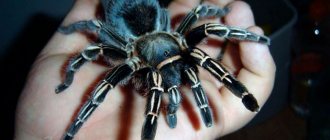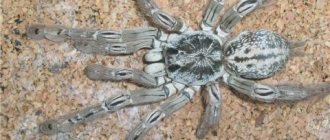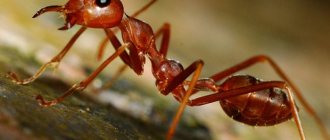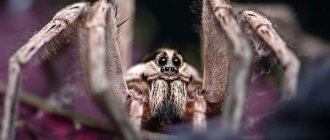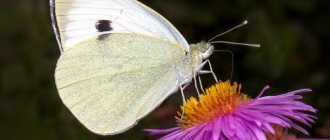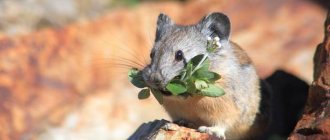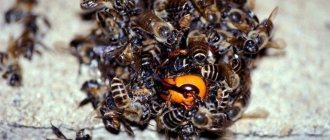What does a tarantula spider look like?
Tarantula spiders are of impressive size, with the cephalothorax smaller than the abdomen. Females are large, but males have a more colorful outfit. Some representatives of arthropods reach a weight of 150 g.
Before getting a tarantula spider as a pet, it is recommended that you familiarize yourself with the main characteristics:
- Thanks to the thick hairs that cover the pet's body, animals feel any vibration created by the objects around them.
- Many people ask how many moving eyes does the tarantula spider have and why does it see poorly? Despite the fact that the animal has 4 pairs of eyes, its vision is worse than ever. The pet can distinguish only some colors and determine the outline of an object.
- In front of the cephalothorax there are pedicles and hairs, thanks to which the spider receives information.
- Near the chelicerae, the claws located near the mouth, there are sacs filled with poison. When the spider is attacked by rivals, it releases venom for protection.
- The hairs are also poisonous. An interesting fact is that tarantula spiders use their paws to clean off the hairs located on their abdomen. Scattering in all directions, they enter the respiratory tract, thereby causing allergies.
- Spiders have 4 pairs of limbs, the span of which is 30 cm.
- Thanks to arachnoid warts, the spider releases mucus from which it makes its home. Mucus hardens in air. In his house, he also combs hairs from his abdomen to increase protection from rodents and insects.
Attention!
Spider venom is dangerous to humans, but is not fatal. Intoxication of the body is expressed in nausea, weakness, impaired coordination of movement, clouding of consciousness.
To reduce the effect of the poison, it is necessary to wash the wound at the site of the bite and take anti-allergy medications.
The tarantula spider can live at home for about 20 years
Mirror spider (Thwaitesia argentiopunctata)
Under a microscope, you can see how the reflective scales on the abdomen pulsate along with the spider's heartbeat
An unusual and very cute spider with sparkles on its abdomen is distributed throughout Australia. It is easy to recognize thanks to the reflective silver spots on its abdomen, but it is difficult to notice. During the day, the miniature spider hides, and at night it builds webs on suitable trees.
Types of tarantula spiders
Scientists have described 143 species of tarantula spiders. Each of them has its own distinctive features, but some varieties require more detailed consideration.
Goliath
Its impressive size made the pet popular. The length of the body together with the limbs is 28 cm. For a long time, Goliath was the largest spider on planet Earth, until at the beginning of the 21st century a species larger than Goliath was found.
The body of the tarantula spider is brown; red or light stains are sometimes visible on the surface. The distribution area is the swampy areas of South America. The spider weighs 170 g.
Goliath
White-knee
Its respectable size, excellent appetite, and bright contrasting color have made the tarantula spider popular among terrarium keepers. An adult white-knuckled Brazilian spider reaches 9 cm, with a paw span of 20 cm. Despite the fact that the arthropods are very aggressive, they are not considered dangerous, since they cannot move quickly.
The tarantula's venom is not dangerous to humans. When hairs come into contact with the skin, irritation appears in the form of redness and there may be itching. They are characterized by slow growth. Males become sexually mature at the age of 2 years, females - 2.5 years. In artificial conditions they can live 15 years.
White-knee
Metal (wood)
Externally, the blue tarantula is similar to other representatives of tree spiders.
Sapphire tarantulas have a shell painted in an incredibly beautiful blue metallic color. When young, the shell of individuals is colored lavender, but becomes blue with age. Males are brighter than females.
Life expectancy is quite high, but males live less than females, about 3 times. Sapphire tarantulas know how to defend themselves well. Their poison is dangerous to humans. When breeding at home, do not touch the spider with your hands.
Metal (wood)
Violet
With each new molt, the coloring of the limbs and body becomes more intense and rich. The purple tarantula spider is considered a rare species. The animal shows aggression, quickly attacks, and defends its habitat.
Spiders become aggressive when other animals, insects, or humans appear near their home. Evening and night are times of active activity.
The beauty of a pet is better visible in sunlight. The furry legs and abdomen of females are dark purple. At the ends of the legs, the hairs grow densely, which allows the females to easily move along rocks and soft ground. However, the color of males is not so bright. Males are gray, with some hairs on their limbs being pink.
Violet
Brachypelma Smitha
The Mexican red-knee tarantula is found in Australia and Mexico. The size of the body is 17 cm. The color of spiders varies: some individuals have a dark brown coat, others have a black coat with red and orange splashes. The hairs are light pink. This species has a calm character, the poison is not dangerous to humans. Every year, when the next molt takes place, the spiders become brighter.
Brachypelma Smitha
Brachypelma Vagans
The most nervous species among all brachypelmas. Differs in speed of movement. The poison is not toxic to humans. Externally the spider is beautiful. The entire velvet body is painted black, the furry legs are dark gray in color, which is shaded with blue, and the abdomen is rich red.
Brachypelma Vagans
Brachypelma Albopilosum
An ideal variety for beginners. Brachypelma Albopilosum is characterized by its large size and peaceful nature. Adults can reach 16 cm in length (if you include paw span). Tarantulas move smoothly and rarely become aggressive.
Growth is slow. The poison is not dangerous to humans and small animals. The average lifespan in a terrarium is 20 years.
Brachypelma Albopilosum
Pink Chilean
Fans of arachnids consider this species to be the most beautiful. The length of the body with the span of the legs is 26 cm. The different colors add attractiveness. On the body and paws you can find brown, chestnut, brown, pink colors.
When kept at home, it requires a certain temperature. He has a friendly, calm character. In captivity it can live up to 15 years.
Pink Chilean
Horse spider
Body length is 10 cm, with a paw span of 25 cm. Males are more slender. Females can weigh 100 g. The spider's homeland is Eastern Brazil. The body of the tarantula is covered with red-brown hairs. Spiders grow quickly and eat a lot. By the first year of life, the length of the body with the span of the legs is 15 cm.
Horse spider
Description and lifestyle
This representative of the arachnid class is large in size and is a record holder in its order. In the wild it lives almost everywhere except in very cold climate zones. Lives in burrows, on the ground, in bushes, and in trees. It has about a thousand species in its family, differing in size, speed of growth and movement, body color and temperament.
Appearance of an arthropod
Due to its unusual appearance, the tarantula spider is widely used as an exotic pet . General family parameters:
- The size of the tarantula spider is from 4 to 7 cm with a leg span of 12 to 18 cm. The average weight is from 60 to 100 grams.
- The body color can be monochrome black, dark burgundy, rich yellow, emerald, etc. It has a chitinous shell. After molting, the birdcatcher spider has its brightest color.
- The entire surface of the body and paws are covered with protective hairs, which the animal can weave into its webs. The hairs on the abdomen are poisonous.
- Gifted by nature with six pairs of legs, four of which are the main limbs. The rest are chelicerae and pedipalps.
Hunting method and types of prey
This type of arachnid, despite its harsh name, rarely indulges in meat. The tarantula feeds on lighter and more accessible food, which is easier for its digestive system to cope with. Doesn't weave a web. The hunter hides in ambush, watches and captures the prey, injecting digestive juices into it. It waits until the food is ready to eat and absorbs the life-giving substance.
Most often the diet includes:
- flies, locusts, grasshoppers and other insects;
- small spiders;
- worms;
- baby frogs, small snakes, fish fry;
- chicks, naked mice.
The spider is not afraid of hunger; its female can go without food for months.
But not only arthropod hunters monitor their potential food; bird catchers can also end up on the table of other individuals of their order, scolopendras and other animals.
https://youtube.com/watch?v=UoxeZ1WmHNU
Features of behavior
The temperament of arthropods varies from calm and friendly to extremely aggressive, depending on the species. But they spend most of their lives lazily, not wasting themselves on meaningless body movements. They can sit in ambush for a very long time.
In addition to the vital attack skills, the spider also has defense techniques. It can bite and inject poison, prick with poisonous hairs and even shoot excrement.
Among other relatives of their order, these individuals are very tenacious, although this only applies to females, whose lifespan can reach up to three decades. Males complete their life path after the cessation of molting or within a year after mating.
Depending on the species, tarantula spiders can have either a friendly or aggressive character.
Continuation of the family line
In preparation for his main mission, the male undergoes changes and “man up.” He develops a cymbium - a vessel with seminal fluid. It is attached to the pedipalps. The spider transfers a certain amount of seed to its web. To hold the obstinate darling, tibal hooks grow on the paws. Having met a female, the spider performs a dance in front of her to convince her that he is the one she needs, of the same species. After the “wedding night,” the male tarantula hurries to leave his new wife, otherwise she, if she was hungry, may unceremoniously eat her husband.
To lay eggs, the mother builds a nest from spider webs and fibers from her belly. The number of future children (50-2000 pcs.) is directly dependent on belonging to a particular species. This spider cocoon protects and monitors the temperature. After 20−106 days, the baby nymphs hatch. After two molts, they develop into larvae similar in appearance to their parents. All this time, the youngsters feed on their own resources, that is, the reserves of nutrients in the abdomen, carefully laid down by nature. After several more molts, the larvae become an imago - a full-fledged adult.
It is worth noting that in the life of a spider, molting is a very important process, practically the engine of the animal’s development. With each shedding of its armor, the tarantula grows and progresses, but also ages. You can tell its age by the number of molts.
How to keep a tarantula spider at home
Keeping a tarantula spider at home has recently become a very popular activity, especially since these pets are beautiful and lead an interesting lifestyle.
How and which spider to choose
List of tarantula spiders for beginners:
- Avicularia - representatives are brightly colored, very often scared of everything in the world;
- Brachypelma - spiders with long hairs, beautifully colored, very nimble;
- Nhandu are large pets with beautiful body coloring and furry legs;
- Lasiodora parahybana is often an aggressive species, the body is colored brown, but under proper conditions of detention it is completely safe.
You should pay attention to the species - Grammostola, beautiful fluffy spiders with sedate body coloring.
Terrarium
Before getting an exotic pet, it is recommended to prepare a terrarium for the exotic tarantula spider. When breeding tree spiders, you will need to prepare a vertical terrarium; for ground and underground inhabitants who like to dig minks, you need a horizontal tank. Height doesn't matter. It is necessary to take care of the ventilation holes, otherwise the spider may get sick.
At the bottom of the terrarium, it is necessary to pour soil 5 cm thick. If the dwelling is being prepared for burrowing species, then the thickness of the litter should be 18 cm.
The following mixtures can be selected as a substrate:
- the soil should be mixed with peat in a 1:1 ratio, sand should be added for young spiders, and vermiculite for adults;
- soil with vermiculite, 5:1;
- coconut substrate with vermiculite and soil;
- pebbles or crushed stone.
Note!
The soil should be light, as spiders can break the chelicerae. While in young individuals they can still be restored, in adult specimens they cannot.
For a spider, it doesn’t matter what to live in, the main thing is that the conditions there are good
Dwelling dimensions
The best terrarium for a tarantula spider should be made of plexiglass. Unlike an aquarium, it may not be sealed because there is no water in the home.
To prevent escape, the spider's house should be covered with a lid with holes made in it to ensure ventilation. The size of each hole must be at least 7 mm.
For your pet, it is better to choose a rectangular container with a height and width of 20 cm. You cannot choose a high terrarium, since in pursuit of live food the spider can fall from a great height and get injured.
If you plan to buy several spiders, then you don’t have to buy separate homes for them; you can buy one terrarium, but you just need to separate them with solid partitions so that the spiderlings are isolated from each other.
Arrangement
For terrestrial species, you can put a piece of driftwood, half a flower pot, a piece of bark or a coconut shell on the bottom as a shelter.
For adults, you need a drinking bowl; you can put a small saucer. An infrared lamp should be installed as lighting if you want to illuminate the terrarium itself. Since spiders are nocturnal, they do not need additional lighting.
The spider does not see infrared light, so such a lamp will not harm it. Lighting should be installed outside the tank so as not to dry out the air.
Climate
The main rule when keeping a tarantula is a temperature of +25-28°C. Using a special heater, temperature changes can be eliminated. Air humidity also plays an important role. In the terrarium it should be maintained at 70-80%.
Soil is very important, as it serves as the basis for the home
Diet
Tarantula spiders are carnivorous animals, so their diet must contain food of animal origin. You can feed flies, cockroaches, mosquitoes, crickets, locusts. The diet of adults may include:
- frogs;
- mice;
- fish;
- chicks;
- snakes;
- caterpillars.
The owner should know that the size of live food should be 2 times smaller than the spider itself. Food should be given in the evening, since arthropods become active closer to night.
You should not overfeed spiders, as this will have a negative impact on their well-being. Adults should be fed 2 times every 7 days, babies - 3 times a week.
If the pet lies on its back and shows no signs of activity, it means that the spider has begun its molting period. At this time, you cannot feed live food. Feeding can be restored only on the 6th day after shedding the shell.
Cleaning the terrarium
It is necessary to clean the terrarium 4 times a month, that is, every week. Cleaning is carried out using thick gloves to prevent aggressive behavior with subsequent attacks. You also need to arm yourself with long tweezers.
In medical practice, there is not a single death recorded from a tarantula bite. However, it can cause a severe allergic rash.
You need to feed the spider live food
Care accessories
To keep an arthropod you will not need to buy any special equipment; it will be enough:
- thermometer;
- infrared lamp;
- hygrometer;
- lamps for heating air.
Attention!
It is necessary to take care of purchasing a device to maintain a certain temperature and humidity. Since these are the basic conditions for keeping a pet, if the parameters are incorrect, the spider may die.
Taming and training
Tarantula spiders do not tolerate training; they cannot be tamed. Any pet, in case of danger, is ready to bite even its owner. Therefore, you should not pick up spiders. Cleaning the terrarium is done with long tweezers.
Experienced spider-keepers note that if tarantulas are handled from a young age, they are less aggressive towards humans when they become adults. However, such an attitude is defined as a blunted reaction to the stimulus “person”.
Spiders are not designed by nature to be pets.
Range and habitats
Tarantula spiders have become quite widespread throughout almost the entire globe, with the only exception being Antarctica . Such arthropods live in Africa and South America, Australia and Oceania, and are also somewhat less common in European countries, where their habitat is limited to the southern part of Italy, Portugal and Spain.
Some tarantula spiders prefer to live in tropical rainforests and equatorial forests. The most drought-resistant species inhabit semi-deserts.
Feeding and prey of the tarantula
The tarantula's diet is not very varied. Such spiders have an external type of digestion. The caught prey is immobilized, after which digestive juice is injected into it, and after a certain period of time, not exceeding a day, the tarantula sucks out the liquid nutritional contents from its prey.
A significant part of the tarantula's diet consists of live insects, the size of which is not too large, which prevents fights between the arthropod and its prey. The largest representatives of tarantula spiders are capable of using small vertebrates in the form of naked mice as food. Also, in captivity, arthropods can be fed small pieces of lean raw meat. The diet of sexually mature tarantulas often includes adult crickets, grasshoppers, large species of cockroaches, and mealworms.
The number of food insects in the diet of an adult individual, as a rule, does not exceed a quarter or a third of the body weight of the spider itself.
When kept in captivity, young and frequently molting tarantulas should be fed approximately a couple of times a week, while adults should be fed once every seven to ten days. Feeding frequency tends to increase before the breeding season begins. Refusal of food is observed at the stage of active molting, at low temperatures or in conditions of severe fullness of the stomach.
Tarantula spiders, for reasons currently unknown to science, can easily starve for almost two years, and a feature of some species is the ability to swim and even dive.
Pros and cons of home keeping
Positive aspects of keeping tarantula spiders in a home terrarium:
- exotic pet;
- fluffy beautiful creatures;
- do not require a lot of feed;
- the pet is interesting to watch;
- do not require much space;
- long lifespan.
In addition, spiders are good for breeding and subsequent sale of babies, since one female can produce offspring of up to 400 spiderlings (in a cocoon).
The disadvantages include:
- inability to be picked up and played with;
- maintaining a certain temperature and humidity;
- causes allergies;
- safety precautions must be observed.
A huge disadvantage is feeding spiders, since they need insects. Not in every city you can buy cockroaches and crickets, so you have to look in nearby cities, which causes some inconvenience.
Arthropods do not require extensive space
Habitat
The sapphire spider is native to India and is found in Andhra Pradesh, the protected forest between Nandyal and Giddalur, and in Sri Lanka. It was first discovered in the center of southern India in the city of Guti at a railway station, for which it received the name Guti tarantula. It is also called Blue Ornamental Tree Spider, Peacock Tarantula, Sapphire Spider, Piceloteria.
It is listed in the Red Book as an endangered species and is on the verge of extinction.
These spiders live in cracks and hollows of trees, and due to deforestation they have lost their natural habitat.
Danger to humans
If the owner is bitten by a tarantula spider, it will not threaten the health of the owner, but can provoke a severe allergy. When carrying out various manipulations, care must be taken. There are recorded cases where cats died as a result of a spider bite. Most likely, the tarantula poses a danger to babies.
The toxicity of the poison depends on the variety. A tarantula bite is equivalent to a wasp sting - a person experiences burning pain, and the site of the injury swells. Depending on the individual reaction, body temperature may rise, muscle cramps, and mental disorders are possible. Most often, dry bites are observed, that is, the spider bites through the skin, but does not let in the poison.
More dangerous are the hairs that it combs from its abdomen. If they come into contact with the skin, they may cause a burn. If it gets into the eyes, there is a strong burning sensation for several hours or days. Toxins impair vision, which cannot be restored.
Is it possible to pick it up?
All breeders of tarantula spiders are interested in this issue. If the arthropod is handled correctly, the animal does not pose a danger to humans. Experts advise taming your pet from the first days it appears in the house. It is necessary to pick it up for a few minutes and then release it into the terrarium.
The degree to which a tarantula becomes accustomed to humans depends on the nature of the arachnid. Over time, the stress will pass, and the spider will feel good in the arms of its owner. The owner can lightly tug at the furry back.
An animal may bite if it feels its life is threatened.
Ultramarine tarantula (Poecilotheria metallica)
Like other tarantulas, Poecilotherium metalica is a fairly large spider, the body can reach a length of 7 cm, and the paw span is 21 cm.
The ultramarine tarantula is endemic to the Indian state of Andhra Pradesh, where its habitat is only 100 square kilometers. km and is highly fragmented as a result of human agricultural activities. The beautiful blue spider was first described in 1899, then unseen by scientists and was considered extinct until it was rediscovered in 2001.
In nature, ultramarine tarantulas live in groups on old trees, adults in the crowns, and young spiders at the foot or in burrows under the roots. They feed mainly on insects. They hunt at night. In cases of very close cohabitation, cannibalism is observed.
Pecilotheria metallica is a very rare and desirable spider among keepers, even despite its complex temperament and poisonous bite. It is considered the most toxic of all tarantulas, the venom causes pain and muscle spasms that can recur for two to three weeks.
Life cycle of a spider
In captivity, tarantula spiders can live from 15 to 20 years. Some individuals even live up to 30 years.
Lifestyle and habitat
The species are found in different climatic conditions. Some prefer to live in tropical forests with high humidity, while others prefer to live in arid regions. Tree spiders weave webs on tree branches; ground dwellers are located under trees. There are underground species that dig holes for themselves to live.
Spiders spend most of their lives in their cozy home. Animals leave it only in search of food or during mating season. In order not to disturb natural biorhythms, tarantula spiders are fed late in the evening.
Nymphs and larvae
Nymphs are newborn spiders that hatch from eggs. Nymphs do not need food at first, so they are allowed to live together. They also lack cannibalism.
In order for a nymph to turn into a larva, it must survive 2 molts, so nymphs of stages I and II are distinguished among them. The external differences between the nymph and the larvae are hardly noticeable. Historically, spiders are called larvae until they become adults.
Shedding
Molting of tarantula spiders –
a key moment in the development of arthropods. In the process, they shed their old exoskeleton and increase in size by 1.5 times. At this time, growth of all solid parts of the body occurs, including the legs. The abdomen grows during the period between molts.
Before shedding the exoskeleton, the spider lies on its back and behaves calmly and does not move. The age of representatives is calculated by the number of molts. Juveniles shed their exoskeleton every month. The older spiders get, the fewer molts they have. For example, adult females molt only once a year.
The spiders themselves will tell you about the approaching moult: young individuals refuse to eat food 7 days in advance, adults - 3 months in advance. Pets' abdomen and body itself darken.
The molting period is an extremely important stage in the life of every tarantula spider.
How long do tarantulas live?
Before purchasing a tarantula as a pet, it is important to know its lifespan. Females live longer than males, approximately 25 years. Males live significantly shorter lives. Their molting process stops when they reach reproductive age. Spiders may die in the same year or die after mating.
A birder will live longer if he is provided with the necessary conditions: a certain temperature, humidity and a balanced diet. In cold conditions, the development of arachnids slows down.
What does a tarantula spider eat in nature?
Do not think that tarantulas feed exclusively on birds. The digestive system is not capable of digesting poultry meat all the time. The menu of arthropods mainly includes insects, small rodents, and arachnids. Cannibalism is sometimes observed.
Spiders go out hunting to catch their prey. To catch another animal, tarantulas set traps - weave a web, and wait for the victim in ambush.
Attention!
The diet consists of frogs, crickets, birds, small rodents, and locusts. In rare cases, a tarantula may catch a small snake or fish. I also don’t mind eating flies, cockroaches, mosquitoes, and bloodworms.
Reproduction
An adult male has cymbiums on his pedipal fingers - special containers that contain seminal fluid. In the area of the 2nd abdominal segment there are genitals. When weaving a web, the tarantula saturates it with sperm. The result is a pyramidal shape. Then he soaks the containers located on the pedipal fingers and goes off to wander in search of a female. Finding her is not difficult - the spider discovers her by following her trail: the female leaves behind a web saturated with endorphins.
If the female is in a hole, this option is the best. When she leaves her home, the gentleman lifts her cephalothorax and runs his pedipal fingers along the epigastric groove with the genital opening. That's it, fertilization is complete. Now the male quickly runs away so as not to become a victim of the female.
The fertilized spider begins to weave a cocoon, into which it will subsequently lay eggs. At one time, the female can lay from 50 to 2,000 eggs, which will remain in the cocoon for 7 weeks.
Every day the female carries out certain manipulations with the cocoon: she turns it over to prevent the eggs from sticking together. This procedure promotes the proper development of the offspring. Soon nymphs appear, which after 2 molts become larvae. They cannot be called full-fledged spiders. The latter name is given to them at the time when the larvae reach sexual maturity.
At one time, the female can lay up to 500 eggs
How to determine the sex of a tarantula spider
To determine the sex of a tarantula spider,
it is necessary to consider the external characteristics and body structure of the male and female. Until puberty occurs, it is almost impossible to determine gender. The male reaches sexual maturity at the age of 1.5 years, the female at 2 years, sometimes at 2.5 years.
Males have:
- thin limbs;
- slender body;
- smaller body size;
- straight chelicerae.
In females, the chelicerae are much larger and convex in shape, resembling a barrel.
It is recommended to examine the abdomen. If it is a male, then in the upper part the epigastric glands are covered with hairs in such a way that they form a kind of arch. Females have a regular straight line, no arch. Males have hairs of different lengths, females have the same lengths.
Tissue damage
One of the common causes of death of tarantulas is damage to body tissue. A whitish fluid (hemolymph) leaks out. Tissues can be injured as a result of a spider falling from a height, from a wall onto a stone or other hard surface.
As a result, the abdomen may rupture. Arachnids very often enter into a fight with large representatives of cockroaches, whose spiked legs can injure the tissues of the tarantula. Crickets can also cause damage through their bite.
If the damage is not severe, then you should monitor the animal’s condition for several hours to make sure that the hemolymph has not leaked out. If not, then it is best to leave the tarantula alone at least for a while.
If leakage is still noticeable, then the damaged area should be very carefully smeared with BF-6 or Vaseline. Vaseline helps keep the fluid from flowing out. The next step is to move the spider to a sterile space.
This will help reduce the risk of contracting an infectious disease. Under no circumstances should you smear wounds and open damaged areas with brilliant green, hydrogen peroxide, iodine or potassium permanganate. The spider may suffer from poisoning.
Some breeders sprinkled the wound with regular wheat flour and wrapped it in a soft napkin. Thus, the wound gradually healed, and the spider did not experience pain or irritation.
Even if the bleeding was stopped, there is a high probability that the spider may die. Like the human body, the structure of the spider's body contains 70 percent liquid. During molting periods, spiders spend the greatest amount of water.
Increased moisture levels help soften the exoskeleton. Dehydration occurs when hemolymph leaks out. The spider's body may not be able to cope with the molting process.
Ticks
The reasons for the appearance and reproduction of ticks can be different: being kept in poor conditions, where there is no ventilation, insufficient humidity, garbage and leftover food. A large number of ticks bother and irritate the tarantula, preventing it from living.
The insect refuses to eat and becomes active only at night. Mites are able to penetrate not only the spider’s lungs, but also the mouth, thus increasing the risk of death. The infected spider must be moved to another container and the mites should be shaken off.
The soil and bedding must be changed immediately and everything should be washed thoroughly with hot water. The tarantula should be kept in another container with a dry cloth for some time.
Gorbatka
The humpback is a miniature black midge. In appearance, it slightly resembles a fruit fly, although it has a slimmer and smaller body. Unlike ticks, the humpback is not capable of causing significant damage to the tarantula, but is a carrier of dangerous diseases.
Its long-term presence in the spider causes a stress reaction. The insect stops eating and combs its fur more and more often. The greatest danger is caused by larvae.
They feed exclusively on flesh. Prevention is very similar to treatment methods for ticks. First, the midges must be eliminated, and then the aquarium must be completely disinfected.
Tarantulas caught in the wild most often suffer from infection by various types of parasites. Timely prevention can alleviate the suffering of the insect, but cannot completely rid it of parasitic midges.
Thus, experts recommend purchasing tarantulas bred in captivity.
Interesting facts about the tarantula spider
The tarantula spider gained popularity due to its large size. Terrarists are attracted by the bright appearance of the pet and the peculiarities of its life. There are many interesting facts related to the life activity of these amazing animals:
- Spiders have never had and never will have a sense of attachment, so they will never be attached to their owner. You should not think that the tarantula loves the owner and will become attached to him.
- The tarantula will never be trained.
- It is impossible to completely exclude the aggressiveness of a spider that lives in a terrarium.
- It happens that completely balanced and calm adult spiders bite their owners.
- Males have larger body sizes than males.
- Females are more expensive because they have a longer life expectancy.
- Females often eat their mates after mating.
- Females lay eggs in a special cocoon made of spider webs. At one time, the female is capable of laying from 50 to 2,000 eggs. After 1.5 months, nymphs hatch from the eggs.
- There should always be a lid on the terrarium to prevent the spider from escaping, especially if there are small children in the house. This precaution will help prevent an accident.
- Spiders cannot be classified as insects, since they belong to a certain class.
- Representatives of arachnids can live 2 years without eating food.
- Tarantulas are the largest spiders on Earth.
- Pets use a very unusual method of defense - blinding their enemy with a stream of feces.
- For patients with phobia – fear of spiders, experts recommend getting tarantulas so that patients can overcome arachnophobia on their own. In most cases, patients are cured of obsessive phobia.
- Some spiders are excellent swimmers; they feel great in water, even diving.
The tarantula spider is a unique animal
Chromatopelma cyaneopubescens maintenance at home:
To keep the beautiful Chromatopelma cyaneopubescens you will need a cubic, or preferably vertical, terrarium. Since the spider is not large, the size of the terrarium may be slightly smaller than the standard 30x30x30 centimeters. If you don’t have a special terrarium, you can use various plastic containers; read for an example of creating an insectarium from a plastic container.
A moisture-absorbing substrate must be placed at the bottom of the terrarium with Chromatopelma cyaneopubescens. Coconut substrate works well, although others will work just as well. I recommend making a layer of substrate at least five centimeters due to the fact that Chromatopelma cyaneopubescens, according to some data, can dig holes (however, I note that I did not observe this with my lameness). A container of clean water must be placed in the terrarium for an adult tarantula spider. Also, the living space for Chromatopelma cyaneopubescens can be decorated with various decorations.
The temperature regime for Chromatopelma cyaneopubescens is 24-26 degrees Celsius. According to information from the Internet, this species can withstand short-term temperature drops of up to 15 degrees, but I, of course, do not recommend checking this information in practice. As mentioned above, Chromatopelma cyaneopubescens is demanding of slightly low humidity of 50-60%, i.e. There is practically no need to moisten the substrate, provided there is a drinking bowl with water.
Prices
Arachnophiles are interested in the price of individual tarantula spiders, because many want to have one as a pet, especially since it is interesting to watch, and the behavior of the animal is not always predictable. The cost of the female is much higher, since she lives longer than the male.
What other factors influence the cost of exotic animals? It's hard to believe, but the price varies according to the aggressiveness scale:
- non-aggressive pet – recommended for beginner arachnophiles;
- moderately aggressive, can bite, but this is rare; Suitable for breeding for arachnid lovers with existing experience;
- an aggressive pet is recommended for keeping only for arachnophiles with experience;
- very aggressive tarantula spiders are generally not suitable for home keeping.
In addition to the factors described above that affect the cost, pets can be divided into categories:
- harmless animals that do not cause difficulties;
- you may encounter minor difficulties in care;
- high difficulties.
When purchasing, it is important to pay attention to indicators such as the number of molts and body size. It should be noted that young individuals molt every month. Molting is usually denoted by the letter “L”.
Chromatopelma cyaneopubescens aggressiveness and danger:
Various sources write conflicting information regarding the aggressiveness and strength of the poison in Chromatopelma cyaneopubescens. The information is so contradictory that somewhere it is praised as “a spider with a complete lack of aggression and low-toxic poison,” and somewhere it is called “Very aggressive and poisonous, only for experienced ones.”
I'll probably add my two cents into this confusion. I have experience working with Chromatopelma cyaneopubescens for about 2 years, there were 3 individuals. I did not notice any aggression on their part; when feeding or changing the drinking bowl (all manipulations were done exclusively with tweezers), my chromes did not jump on the tweezers, as, for example, Mirinus likes to do.
Moving quite quickly is Chroma style. Here it sits in a visible place, you open the door of the terrarium, and a second later the spider is in its hiding place. As a rule, in case of danger or the appearance of irritants, chromes rush to the shelter.
As for the bite of Chromatopelma cyaneopubescens, according to reports from foreign sites and from the words of very experienced keepers, we can conclude that the poison of Chromatopelma cyaneopubescens does not pose any particular danger. The consequences of a Chromatopelma cyaneopubescens bite can be: pain, swelling and redness. However, I hasten to remind you that the consequences can be much more serious if you are allergic to bee or wasp venom.
Chromatopelma cyaneopubescens combs off irritating hairs quite actively. It is worth considering this and always wash your hands under warm water after handling any tarantulas that have stinging hairs.
To summarize, I want to say that Chromatopelma cyaneopubescens can be recommended even to a confident beginner who can restrain the desire to constantly carry the chromium in his hands, and will not forget to follow standard safety precautions when working with a spider.
Reviews
Before you buy a tarantula spider for home keeping, it is important to decide for yourself whether you are ready to provide it with comfortable living conditions. Pets need a certain temperature and humidity. Animals must be fed properly. The diet should contain food of animal origin. Families with small children are not recommended to own a tarantula spider, since it is unknown how the baby’s body will react if the child is bitten by an exotic pet.
Did you learn something new? Share in the comments!
Annamese stick insect content:
Ostriches: types, description of breeds, photos, videos, how to care for them, what they eat!
Annamese stick insects are best kept in high containers, as these insects like to climb high. But just a tall container is not enough; it is necessary to “equip” the container with edible twigs. Annamese stick insects are very demanding on the air humidity in the container, so it needs to be sprayed and the soil watered. Peat, coconut substrate, or simply sawdust from deciduous crops (preferably fruit trees) are suitable as soil. It is advisable to maintain the temperature in the range from 26 to 28 degrees. Annamese stick insects are able to crawl on glass, so the container must be covered with mesh or fabric.
The spider is molting. What to do?
The exoskeleton (cover) of spiders cannot increase, ensuring the constant growth of its owner. Evolutionarily, this problem was solved with the help of molting, during which the old exoskeleton is replaced with a new, larger one. This is the most important and most critical period in the life of a tarantula. When molting occurs, it is necessary to slightly increase the humidity level in the terrarium. Any interference in the life processes of the spider during this period can result in its death. Therefore, under no circumstances should you disturb or pick him up during molting.
Spiders molt constantly throughout their lives, and the older they are, the longer the intervals between exoskeleton changes. However, unlike females, males stop molting when they become sexually mature. And they live less than their friends - 2-5 years, while spiders live up to 10-40 years.
Lifestyle
Where do they live?
Under natural conditions, these spiders are active at night, and during the day they hide in the crowns of trees. Also, young individuals often make homes for themselves at the base of a tree in earthen burrows, disguising them with cobwebs. Blue spiders live mainly in groups.
Help! The venom of these arthropods is potent. A human bite from an adult can lead to various allergic reactions, headaches, nausea, dizziness and fever.
Nutrition
Blue arthropods are predators. They do not feed on birds; the basis of their diet consists of grasshoppers, larvae of various insects, other smaller spiders and beetles, small frogs, locusts, etc. The spider's food does not exceed it in size; it does not dare to attack large prey. These predators do not use the web for hunting, but simply attack the prey. Having overtaken the prey, it injects poison into it, which paralyzes the victim’s body. Then it weaves a web around the insect and releases stomach acid into the immobilized body. After a short period of time, the insides of the prey soften and the predator begins to feed.
The appearance of offspring
If fertilization is effective, then after 2 months the female lays eggs. Shortly before the predicted laying, it is recommended to replace the soil or clean the terrarium. All remaining feed is removed, preventing the process of rotting. The drinking bowl is cleaned and filled with clean water.
Formation of a cocoon by a female tarantula spider
When breeding tarantula spiders at home, it is necessary to follow the rules of hygiene for arthropods. Individuals are fed protein food: darkling beetle larvae, Madagascar cockroaches.
- If the female begins to abundantly weave the terrarium with cobwebs. This means that she is preparing to lay. It lines the bed, which consists of dense fabric.
- The spider lies down on him and releases eggs from her abdomen. They come out along with a viscous liquid. At this time, the female’s abdomen sharply decreases.
- After laying, the individual begins to collect the entire web into a cocoon. It looks like a small ball.
- The spider constantly moves the cocoon to certain places in the terrarium, looking for the optimal microclimate.
- The air temperature in the container is kept at 24 0C, the humidity is increased to 70%, but you should always be based on the characteristics of the subspecies. Some spiders require higher air temperatures and maximum humidity.
- The incubation period lasts 1-2 months, but already at 35 days nymphs appear in the cocoon. The female helps them break the cocoon.
After the spider has formed a cocoon, it is recommended to inspect it for integrity. Young females do not completely cover the clutch with cobwebs. The eggs may die.
To prevent this from happening, it is recommended to take the cocoon from the female by tossing her a dummy. The holes in the cocoon are sewn up with silk thread and returned to the female. If she does not accept it, then incubation is performed artificially.
Nymphs emerge from the cocoon. They are placed in a separate container, provided with high humidity, and maintained at a temperature of 26-28 0C. You don't need to feed them. They feed on egg yolk. After a month they develop into larvae. I distribute the young animals into separate containers and begin feeding.
The larvae are kept at a temperature of 22-26 0C. Air humidity 70%. You need to be prepared for the fact that tarantulas are fertile. The required number of terrariums and food insects should be prepared.
YouTube responded with an error: The request cannot be completed because you have exceeded your quota.


